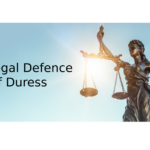He Made Me Do It! Duress in Criminal Cases

Duress is a legal defence that applies when a person is forced to commit the actions which comprise a criminal offence.
Duress is a complete defence, which means a person charged with a criminal offence will be found not guilty if the person’s actions were undertaken under duress.
In a nutshell, three elements (or ingredients) are required to raise the defence of duress. These are:
- There were threats of death or really serious injury to the person or a member of the person’s family;
- Those threats were of such a nature that a person of the same sex and maturity in the person’s position at the time, and
- The circumstances were such that a person in that position would have given in to the threats and committed the crime demanded of them.
Duress is a form of “compulsion,” where the person’s will is overpowered to such an extent their actions are no longer considered to be voluntary.
Duress is a complete defence
In criminal law, it is generally accepted that individuals should not be punished or held responsible for actions they did not perform voluntarily.
This principle makes duress a well-established defence in most criminal cases in New South Wales – the notable exception being murder, where duress does not apply.
In the event a person is able to raise evidence they may have acted in duress, the onus then shifts to the prosecution to prove beyond reasonable doubt this was not the case.
But how is duress assessed in the courtroom?
There are specific steps that the ‘fact-finder’ — such as a magistrate in the Local Court or a jury in the District Court — must follow when evaluating a claim of duress. The first step is to determine whether there is evidence to support the claim of duress.
To determine whether evidence of duress exists, the fact-finder must be convinced that there is sufficient evidence to support the following:
- Firstly, the defendant genuinely believed that there was an immediate threat of death or serious injury to themselves or another person. It is not important whether this belief was incorrect, as long as it was sincerely held (subjective test).
- Secondly, a person of ordinary firmness of mind in the same position as the defendant could similarly have had their own overborne and acted in the same way (objective test). In making an assessment, the fact-finder should take into account a whole range of factors including the defendant’s level of maturity, their gender and all of the surrounding circumstances.
Ultimately, this means there must be evidence that the defendant believed they were facing imminent danger and that their response could be seen as reasonable under the circumstances.
If the defendant presents such evidence, the prosecution must then disprove the possibility of duress beyond a reasonable doubt. If the prosecution fails to do so and cannot prove beyond a reasonable doubt that the defendant was not acting under duress, the defendant will be found not guilty, as duress constitutes a ‘complete defence’.
Non-exculpatory duress as a mitigating factor
In the event a person pleads guilty despite the defence of duress potentially being available, or if the charge faced is one of murder, elements of duress can act to reduce the sentence (penalty).
In New South Wales, a variety of mitigating factors and aggravating factors and are listed in section 21A of the Crimes (Sentencing Procedure) Act 1999 (NSW) (the Act).
If duress is raised as a defence but does not constitute a “complete defence,” the court is still required to consider the evidence of duress as a mitigating factor during sentencing. Section 21A(3)(d) of the Act states that circumstances where “the offender was acting under duress” is recognised a mitigating factor.
The case of Lithuanian Man, A. T.
In the case of Lithuanian man, (A.T.) the defendant was charged in Australia following an alleged drug importation.
In 2007 the A.T. (the defendant) booked a storage unit under a false name and was listed as the consignee of a sculpture which was found to contain a large quantity of drugs. The defendant drilled a hole in the pillar of the sculpture and took out several pills.
During a second trip to Australia later that year, the defendant handed some pills to a man he had been instructed to contact. Following this, Federal Police examined the pillar and discovered 182.2 grams of powder, which was later examined to contain 55.1 grams of pure MDMA. The defendant was charged with aiding and abetting the importation of border controlled drugs, as well as possession of a marketable quantity of the same drug.
However, the defendant presented a different version of events, claiming he acted under the threat of violence. He explained that after arriving in Australia, he became addicted to drugs after meeting a Russian man at a nightclub who supplied him with drugs for free. Over time, the Russian man demanded payment of approximately $42,000 AUD for the drugs the defendant had used.
The defendant claimed he explained he could not afford such a sum, and the Russian man then offered to find him a job to repay the debt. According to the defendant, the Russian man then threatened him with a gun, saying he would rape and shoot his girlfriend if he did not comply. The Russian man allegedly repeated this threat multiple times, warning that harm would come to the defendant’s girlfriend if he reported the matter to the police. Fearful for his own safety and that of his girlfriend, the defendant agreed to collect the sculpture and deliver the drugs.
Despite explaining his version of events, the defendant chose to plead guilty rather than maintain a not guilty plea and face a jury trial.
In criminal cases, pleading guilty can result in a defendant receiving a sentencing reduction of up to 25%, commonly referred to as a “utilitarian discount.” This reduction is given because it saves court time and public resources.
The reasons behind the defendant’s decision to plead guilty remain unclear. He may have believed it would be too challenging to present sufficient evidence of duress, or he may have thought the prosecution would successfully prove beyond a reasonable doubt that he was not acting under duress.
In any event the defendants defence lawyer sought to raise duress as a mitigating factor during his sentencing.
Despite the plea of guilty and claims of duress the offence was far too serious to save the defendant from imprisonment. The defendant received a prison sentence of 10 years for the commercial importation charge with a non-parole period of 6 and a half years. The non-parole period is the time a defendant must spend in prison before being eligible to apply for release.
The defendant had later sought to appeal the sentence on the basis that it was ‘manifestly excessive’ because the judge did not give sufficient weight to the existence of duress.
Case in point
A.T. appealed the decision to the NSW Court of Criminal Appeal (CCA).
The CCA explored the issue of non-exculpatory duress during sentencing. The court notes that the primary motivation for criminal offences is normally malice or greed, rather than fear. Additionally, the usual motive for drug importation is greed.
The CCA pointed out that motive is relevant to assessing the seriousness of many criminal offences, and that offences committed out of fear may be considered less serious than the same offences committed out of malice or greed.
Ultimately, the CCA found that the defendant should have received a shorter sentence, despite the strong need for ‘general deterrence’ (i.e. deterring others) in drug importation cases. The defendants full term sentence for the most serios charge of commercial importation was therefore reduced to 8 years with the non-parole period being reduced to 5.
Using duress as a defence
The effectiveness of using duress as a defence will depend on the individual circumstances of any given case.
Indeed, the CCA in A.T. made it clear that case is not to be used as a precedent for sentence reductions for partial duress, stating:
“Before concluding this judgment, I should emphasise that this is a particularly unusual case. Although the statements of principle contained in the judgment may have general application, the decision, on its facts, has no precedential value. The decision should not be taken to provide a benchmark for reduction of a sentence on the grounds of non-exculpatory duress.”
Going to Court?
If you or a loved-one are facing criminal charges and believe the defence of duress may be available, contact Sydney Criminal Lawyers to arrange a free first conference who will evaluate the situation, explain the way forward and fight for the optimal outcome.






